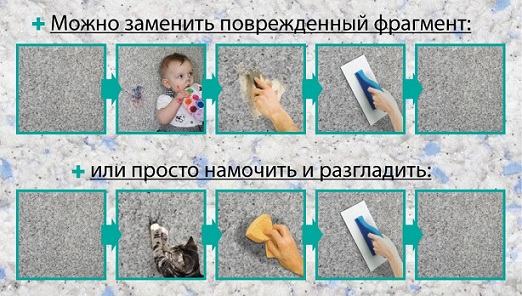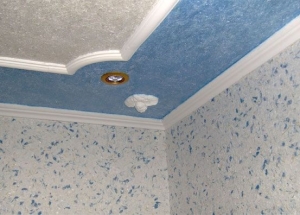Decorative silk plaster, best known among admirers under the name of "liquid wallpaper", is an excellent material, perfectly suited not only for wall decoration, but also for spectacular decoration of the ceiling surface. Simplicity and cost-effectiveness of such decorating is comparable only with standard whitewashing. A special pulp and paper base with decorative elements and dyes gives the ceiling design a sense of uniqueness and exclusivity, and a unique technology of application separates liquid wallpaper into a separate group of the most attractive finishing materials.
Content
Properties of liquid wallpaper
Repair of housing involves carrying out a variety of different operations, but the most interesting and exciting stage is finishing finish, in the process of which all participants anticipate the joyful moments of achievement of the result. Determine the finishing materials for finishing the apartment today is incredibly difficult, because the construction market offers countless wallpapers, plasters, paints and other materials. It's so easy to get lost in this vast assortment. The latest trend in the development of design art, which allows you to get a quality and incredibly beautiful surface, is the use of liquid wallpaper. Ecological and fire safety, stability of changes in temperature and humidity, ease of maintenance and repair, and most importantly, excellent leveling properties determine the possibility of using liquid wallpaper not only for finishing the surfaces of residential premises, but for country cottages, offices and shopping centers.
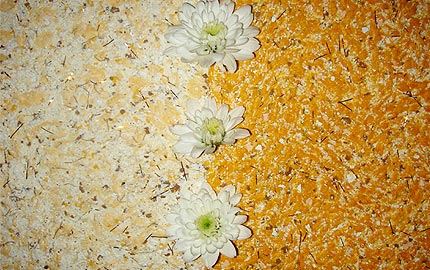
Thanks to the interspersing of metal and gold threads, silk fragments, woolen and cotton fibers, all kinds of dyes, decorative plaster becomes an excellent material for decorating surfaces and giving them an original kind of textiles. Creating a one-tone surface and ceiling with the effect of expensive fabric drapery or classic stucco, a successful combination of a number of monochrome fragments, a magnificent imitation of elite varieties of natural stone - these and many other visual effects you can get using a unique technology of liquid wallpaper.
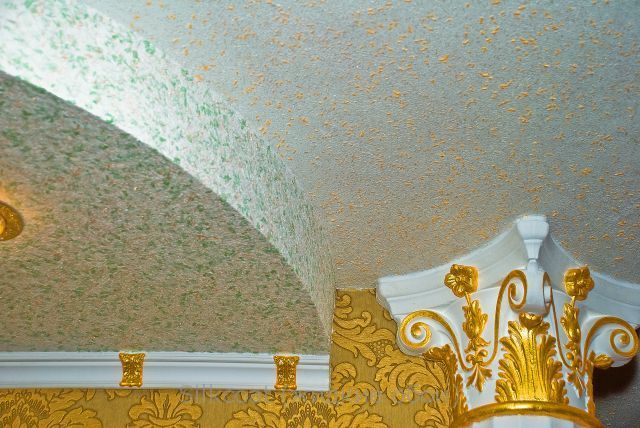
Advantages of liquid wallpaper
- The expression "liquid wallpaper" in most home owners is associated with traditional wallpaper, but only knowledgeable in the construction industry, a person knows that liquid wallpaper has nothing to do with conventional roll wallpaper: they do not need to be laid out on the floor, abundantly lubricated with glue and applied to the surface . The process of preparation of liquid wallpaper for direct use is strictly according to the instructions and consists in the correct preparation of the mixture and applying it to the prepared surface with a trowel or spatula.
- The result of the application of liquid wallpaper becomes a perfectly smooth, seamless surface.
- Liquid-type wallpapers allow you to hide cracks and other minor surface defects, forming a single finish without any flaws.
- Unlike a number of finishing materials, liquid wallpaper "breathe", they are water and water resistant, which prevents the development of dampness, mold, and greenhouse effect in the room.
- Aesthetic beauty of decorative design. A magnificent combination of different color and texture solutions make it possible to create a real artistic masterpiece or a magnificent picture in your home.
- Easy application and the ability to restore the coating.
- Environmental safety and durability (more than 10 years).
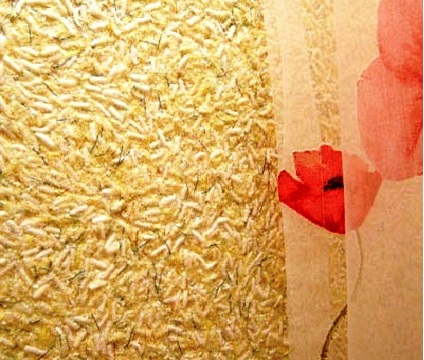
Disadvantages of liquid wallpaper
- Since liquid wallpaper is a new, high-tech solution in the repair and finishing area, but their cost is slightly higher than the traditional options for decorating surfaces.
- Moisture resistance, which is endowed with liquid wallpaper, can not be confused with detergent-type materials. Liquid-type wallpapers are not at all designed for washing. The soiled or spoiled area is not washed with soap solution, and the defect can be removed, only by cutting out this area and treating the resulting hole with the remnants of the diluted mixture in water. However, this defect can be attributed to advantages rather quickly, because with ordinary wallpaper such a number does not pass.
- To obtain an effective result, it is better to use the help of professional designers who will create an original decorative solution not only of the ceiling, but of the whole room. It should be remembered that the wallpaper of liquid type silk plaster is not combined with paper, non-woven, and even fiberglass wallpaper.
- Despite the ability of liquid wallpaper to visually hide the disadvantages of the surface to be decorated, the procedure for applying to the ceiling, in contrast to walls, is best done only after thorough preparation of the substrate and putting it under a single level. This need is caused by the presence of lighting devices, the outgoing light flux of which clearly illuminates even small depressions and bumps. For a thorough leveling of the ceiling, it is possible to form suspended ceilings or use putty. In the case of creating multi-level suspended ceilings, it is logical to use a combination of several shades and textures of liquid wallpaper to produce a colorful and unusual cloth.
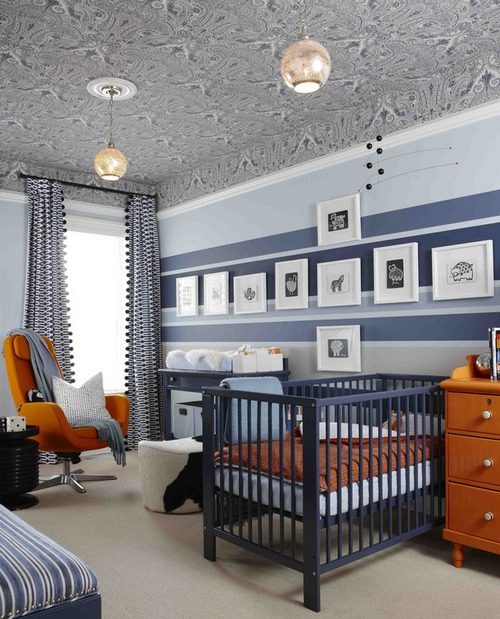
Consumption of liquid wallpaper
To calculate a sufficient amount of the consumption mixture, the following formula is used: 1 kg of the mixture is sufficient for 5 m 2 of the ceiling surface. If the area of your surface is 15 m², then you need at least 3 kg of material.
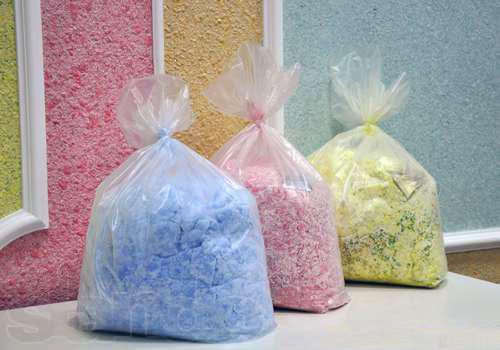
Instruments
To apply liquid wallpaper yourself, you will need:
- directly liquid wallpaper;
- container for preparing wallpaper;
- trowel or spatula;
- rubberized roller;
- embossed roller.
Ready mixture is applied to the ceiling with a special spatula or spray. The alignment procedure is carried out using a roller, while the thickness of the plaster layer varies from 1.5 to 5 mm.
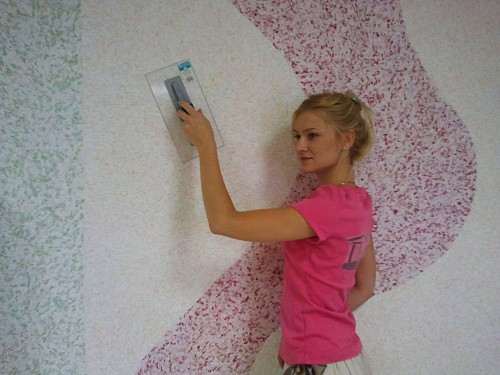
Application technology
The technology of applying liquid wallpaper does not conceal the pitfalls and special difficulties, it will be able to successfully cope with it both as a beginner performer and as an experienced professional.
- the surface is cleaned of worn finishings (wallpaper, whitewash, paint), dust and dirt;
- ceiling space is treated with antiseptics to prevent the formation of fungi and mold;
- is primed with acrylic mixtures and other priming agents in accordance with the type of ceiling coating;
- while the primed surface dries, you can do the preparation of a solution of liquid wallpaper. To do this, the contents of the package are poured into a prepared container and mixed with water and additional components according to the instructions that are attached to the liquid wallpaper. Observing the exact proportions, you can get a solution of the right quality and the right, homogeneous consistency. The solution should be thoroughly mixed for 15-20 minutes and the same to withstand for swelling. It should be remembered: to obtain a high-quality coating of one surface, it is necessary to use liquid wallpaper of one batch and one batch;
- a ready solution of liquid wallpaper should be applied to the ceiling surface with a spatula and gently rubbed with a roller or grater. The temperature in the room must be at least 10 ° C;
- depending on the temperature and humidity levels, the drying time of the coating is 12 - 72 hours.
- the quality and reliability of the application will not deteriorate if windows and doors are opened at the time of operation.
The technology of applying wallpaper of a liquid type is presented in a video on youtube.
Caring for surfaces treated with liquid wallpaper is easy enough: it uses soft napkins or sponges, a stain remover solution, and areas of the surface with mechanical damages are quickly and easily replaced with new material.
